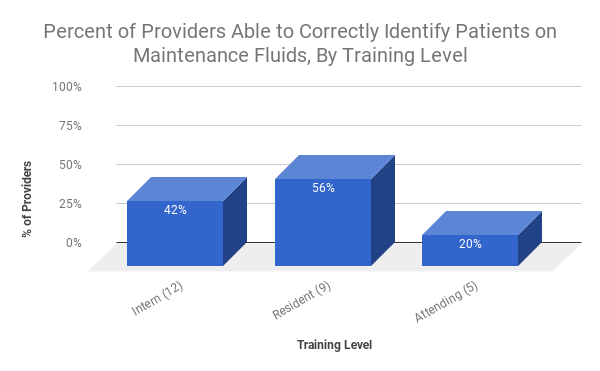Background: Continuous intravenous (IV) infusions aimed at avoiding dehydration are often referred to as “maintenance fluids” (MF). These infusions are common in clinical practice. Though guidelines exist for MF use in other countries (NICE 2017), there are no specific guidelines in the US. A shortage of IV fluid has existed since 2013. In 2017, Hurricane Maria affected major suppliers (located in Puerto Rico), which catapulted the nation into a true crisis. Although the literature indicates that inappropriate use of IV fluids can be harmful to patients, little has been published exploring how providers approach prescribing MF. We performed a multifaceted needs assessment at an urban, academic tertiary care center to explore awareness regarding MF prescribing on inpatient internal medicine (IM) services, with the goal of informing a quality improvement project to decrease unnecessary IV fluid use.
Methods: We conducted a cross-sectional survey of interns, residents and hospitalists in November 2017. MF were defined as normal saline, half normal saline, lactated ringers, plasmalyte and 5% dextrose, administered at rates from 25-150 cc/hr for >12 hours. We reviewed the EMR of each patient cared for by these teams to identify patients with active MF orders. Each provider was given a copy of his/her patient list and asked to identify patients prescribed MF in the last 24 hours, without looking at the EMR.
We also conducted an electronic survey of pharmacists, nurses, nurse practitioners, and physicians to assess attitudes and knowledge surrounding MF management.
Results: The cross-sectional survey was administered to 26 providers (12 interns, 9 residents, 5 hospitalists) on 12 inpatient teams. The mean number of patients per team was 6.5 (range 3 – 10). 10% of patients were prescribed MF. Only 46% of providers correctly identified patients receiving MF. Stratified by level of training, we found that 42% of interns, 56% of residents, and 20% of hospitalists correctly identified patients receiving MF. (Table 1)
The results of our electronic provider survey (n=43) show that 60% of providers are unaware of guidelines for MF use, and 93% of providers felt that MF were used at times without a clear indication. There was a large variation in reported practice patterns of MF prescribing. 47% of pharmacists (n=17) believe that providers do not properly prescribe and monitor MF, and that MF are overprescribed.
Conclusions: Given the current national shortage, IV fluid prescribing is a timely area for innovation and intervention. A focus on IV fluids will be increasingly important as the supply dwindles. Currently there is a clear lack of awareness and understanding among clinicians about which of their patients are on MF. We are developing educational interventions for clinicians and nurses, and instituting an EMR-based intervention to reduce unnecessary MF use. We plan to expand this work to the other institutions in our hospital system.

